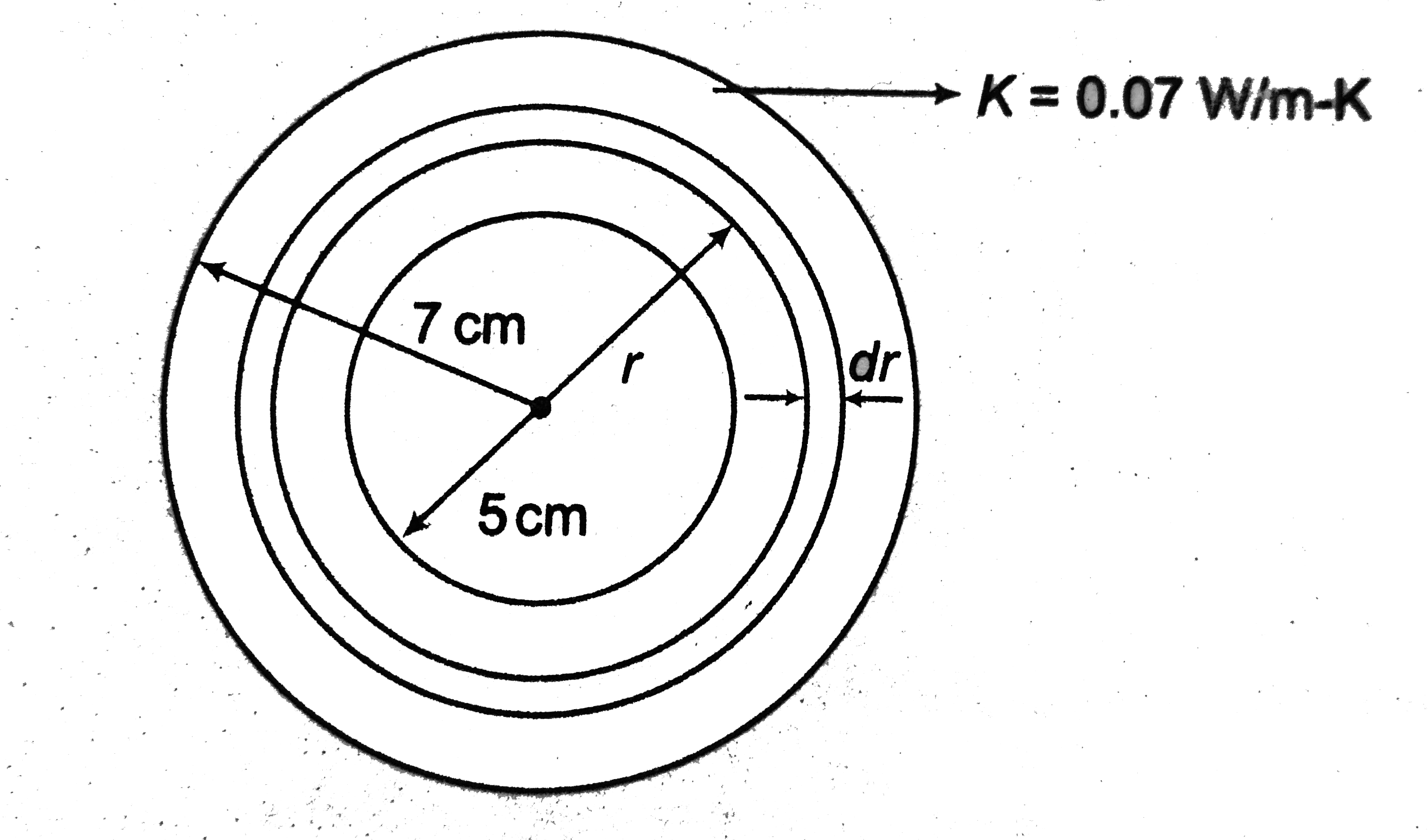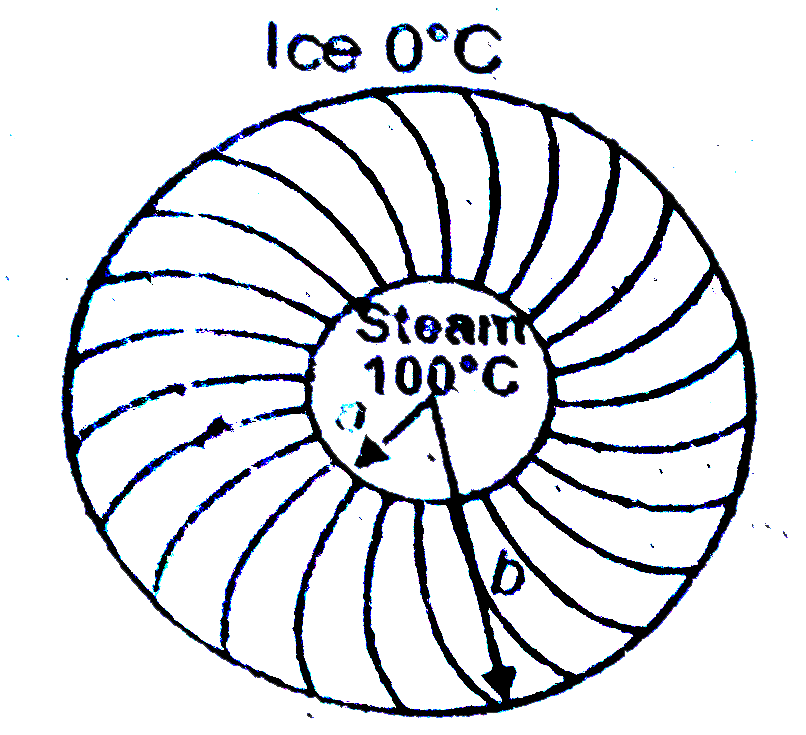A steam cylindrical pipe of radius 5 cm carries steam at 100∘C . The pipe is covered by a jacket of insulating material 2 cm thick having a thermal conductivity 0.07 W/m−K . If the temperature at the outer wall of the pipe jacket is 20∘C , how much heat is lost through the jacket per metre length in an hours?
 .
.
The correct Answer is:A, C
Thermal resistance per metre length of an element at distance r of thickness dr is
dR=drK(2πr) (R=lKa)
∴ Total resistance R=∫r2=7cmr1=5cmdR
=12πK∫5.0×10−2m7.0×10−2mdrr
=12πKIn(75)
=1(2π)(0.07)In(1.4)
= 0.765 K/W
Heat current , H=Temperature differencethermal resistance
100−200.765=104.6W
∴ Heat lost in one hour=Heat current×time
=(104.6)(3600)J
=3.76×(105)J.
Topper's Solved these Questions
- CALORIMETRY & HEAT TRANSFERBOOK - DC PANDEY ENGLISHCHAPTER - CALORIMETRY & HEAT TRANSFEREXERCISE - Exercise 22.1
7 Videos
- CALORIMETRY & HEAT TRANSFERBOOK - DC PANDEY ENGLISHCHAPTER - CALORIMETRY & HEAT TRANSFEREXERCISE - Exercise 22.2
7 Videos
- CALORIMETRY & HEAT TRANSFERBOOK - DC PANDEY ENGLISHCHAPTER - CALORIMETRY & HEAT TRANSFEREXERCISE - Example Type 4
4 Videos
- BASIC MATHEMATICSBOOK - DC PANDEY ENGLISHCHAPTER - BASIC MATHEMATICSEXERCISE - Exercise
13 Videos
- CALORIMETRY AND HEAT TRANSFERBOOK - DC PANDEY ENGLISHCHAPTER - CALORIMETRY AND HEAT TRANSFEREXERCISE - Medical entrance s gallery
38 Videos
Similar Questions
The dimensions of a brick wall of a living room are: thickness 40 cm, width 5 m and height 2.8 m. A temperature of 20∘C is maintained inside the room, the temperature outside being −15∘C. How much heat is lost through this wall in 24 hours?
View SolutionA solid sphere of radius b=4cm has a cavity of radius a=2cm. The cavity is filled with steam at 100∘C. The solid sphere is placed inside the ice at 0∘C. Thermal conductivity of material of sphere is 0.5 W/m.∘C. If ther ate of flow of heat through the sphere radially is xπJ/s then find the value of x.

View Solution
The only possibility of heat flow in a thermos flask is through its cork which is 75cm2 in area and 5 cm thick its thermal conductivity is 0.0075cal/cm−s−∘C. The outside temperature is 40∘C and latent heat of ice is 80cal/g. Time taken by 500 g of ice at 0∘C in the flask to melt into water at 0∘C is
View Solution
The only possibility of heat flow in a thermos flask is through its cork which is 75cm2 in area and 5 cm thick its thermal conductivity is 0.0075cal/cm−s−∘C. The outside temperature is 40∘C and latent heat of ice is 80cal/g. Time taken by 500 g of ice at 0∘C in the flask to melt into water at 0∘C is
View SolutionA carpenter builds an outer house wall with a layer of wood 2.0 cm thick on the outside and a layer of an insulation 3.5 cm thick as the inside wall surface. The wood has K=0.08W/m.K and the insulation has K=0.01W/m.K . The interior surface temperature is 19∘C and the exterior surface temperature is −10∘C.
(a) What is the temperature at the plane where the wood meets the insulation?
(b) What is the rate of heat flow per square metre through this wall ?
View SolutionA closed cubical box is made of perfectly insulating material and the only way for heat to enter or leave the box is through two solid cylindrical metal plugs, each of cross sectional area 12cm2 and length 8cm fixed in the opposite walls of the box. The outer surface of one plug is kept at a temperature of 100∘C . while the outer surface of the plug is maintained at a temperature of 4∘C . The thermal conductivity of the material of the plug is 2.0Wm−1C−1 . A source of energy generating 13W is enclosed inside the box. Find the equilibrium temperature of the inner surface of the box assuming that it is the same at all points on the inner surface.
View SolutionA rod of negligible heat capacity has a length of 50 cm, area of cross section 5cm2 and thermal conductivity 500 W/m∘C. The temperature of one end is maintained at 0∘C and that fo the other end is slowly and linearly varied from 0∘C to 60∘C in 20 min. Assuming no heat loss through the lateral side, the total heat transmitted throught he rod in 20 minutes is
View SolutionWater is boiled in a container having a bottom of surface area 25cm2 , thickness 1.0mm and thermal conductivity 50Wm−1C−1 , 100g of water is converted into steam per minute in the steady state after the boiling starts. Assuming that no heat is lost to the atmosphere, calculate the temperature of the lower surface of the bottom. Latent heat of vaporization of water =2.26×106Jkg−1 .
View SolutionA cylinder of radius R made of a material of thermal conductivity K1 is surrounded by a cylindrical shell of inner radius R and outer radius 2R made of a material of thermal conductivity K2. The two ends of the combined system are maintained at two different temperatures. There is no loss of heat across the cylindrical surface and the system is in steady state. The effective thermal conductivity of the system is
(a) K1+K2 (b) K1K2/(K1+K2)
(c )(K1+3K2)/4
(d) (3K1+K2)/4.
View SolutionA cylindrical block of length 0.4 m and area of cross-section 0.04m2 is placed coaxially on a thin metal disc of mass 0.4 kg and of the same cross - section. The upper face of the cylinder is maintained at a constant temperature of 400 K and the initial temperature of the disc is 300K. if the thermal conductivity of the material of the cylinder is 10watt/m−K and the specific heat of the material of the disc is 600J/kg−K, how long will it take for the temperature of the disc to increase to 350 K? Assume for purpose of calculation the thermal conductivity of the disc to be very high and the system to be thermally insulated except for the upper face of the cylinder.
View Solution
